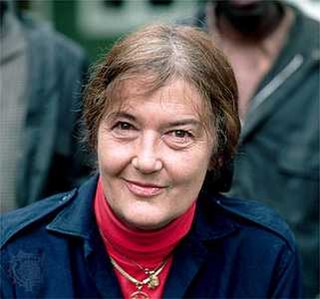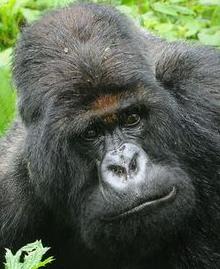
Gorillas are herbivorous, predominantly ground-dwelling great apes that inhabit the tropical forests of equatorial Africa. The genus Gorilla is divided into two species: the eastern gorilla and the western gorilla, and either four or five subspecies. The DNA of gorillas is highly similar to that of humans, from 95 to 99% depending on what is included, and they are the next closest living relatives to humans after chimpanzees and bonobos.

Hanabiko "Koko" was a female western lowland gorilla. Koko was born in San Francisco Zoo, and lived most of her life at The Gorilla Foundation's preserve in the Santa Cruz Mountains. The name "Hanabiko" (花火子), lit. 'fireworks child', is of Japanese origin and is a reference to her date of birth, the Fourth of July. Koko gained public attention upon a report of her having adopted a kitten as a pet and naming him "All Ball", which the public perceived as her ability to rhyme.

Dian Fossey was an American primatologist and conservationist known for undertaking an extensive study of mountain gorilla groups from 1966 until her murder in 1985. She studied them daily in the mountain forests of Rwanda, initially encouraged to work there by paleoanthropologist Louis Leakey. Gorillas in the Mist, a book published two years before her death, is Fossey's account of her scientific study of the gorillas at Karisoke Research Center and prior career. It was adapted into a 1988 film of the same name.

Apes are a clade of Old World simians native to sub-Saharan Africa and Southeast Asia, which together with its sister group Cercopithecidae form the catarrhine clade, cladistically making them monkeys. Apes do not have tails due to a mutation of the TBXT gene. In traditional and non-scientific use, the term ape can include tailless primates taxonomically considered Cercopithecidae, and is thus not equivalent to the scientific taxon Hominoidea. There are two extant branches of the superfamily Hominoidea: the gibbons, or lesser apes; and the hominids, or great apes.

The mountain gorilla is one of the two subspecies of the eastern gorilla. It is listed as endangered by the IUCN as of 2018.

The Cross River gorilla is a critically endangered subspecies of the western gorilla. It was named a new species in 1904 by Paul Matschie, a mammalian taxonomist working at the Humboldt University Zoological Museum in Berlin, but its populations were not systematically surveyed until 1987.

Knuckle-walking is a form of quadrupedal walking in which the forelimbs hold the fingers in a partially flexed posture that allows body weight to press down on the ground through the knuckles. Gorillas and chimpanzees use this style of locomotion, as do anteaters and platypuses.
This is a list of countries banning non-human ape experimentation. The term non-human ape here refers to all members of the superfamily Hominoidea, excluding Homo sapiens. Banning in this case refers to the enactment of formal decrees prohibiting experimentation on non-human apes, though often with exceptions for extreme scenarios.
Craig Stanford is Professor of Biological Sciences and Anthropology at the University of Southern California. He is also a Research Associate in the herpetology section of the Los Angeles County Natural History Museum. He is known for his field studies of the behavior, ecology and conservation biology of chimpanzees, mountain gorillas and other tropical animals, and has published more than 140 scientific papers and 17 books on animal behavior, human evolution and wildlife conservation. He is best known for his field study of the predator–prey ecology of chimpanzees and the animals they hunt in Gombe National Park, Tanzania, and for his long term study of the behavior and ecology of chimpanzees and mountain gorillas in Bwindi Impenetrable National Park, Uganda.
Max was a western lowland gorilla held at the Johannesburg Zoo who in 1997 was shot and wounded by Isaac Mofokeng, a criminal who entered his enclosure at the zoo while attempting to evade police.
Michael was the first male 'talking' gorilla. He had a working vocabulary of over 600 signs in American Sign Language, taught to him by Koko, a female gorilla; Francine Patterson ; and other staff of Stanford University. Michael, an orphan, spent most of his life in Woodside, California, where he became a local celebrity and painter, creating vividly colourful abstract works.

Tarzan II is a 2005 American direct-to-video musical animated film, and the third Disney Tarzan film after Tarzan and Jane, though it chronologically takes place during the events of the original film set during Tarzan's childhood, years before he met Jane. It was produced by Walt Disney Pictures and DisneyToon Studios Australia, with animation outsourced to Toon City Animation. Taking place during Tarzan's youth and before his adulthood, the film follows Tarzan's adventure to discover who he really is. Glenn Close and Lance Henriksen reprise their roles as Kala and Kerchak from the first film while Harrison Chad, Brenda Grate, and Harrison Fahn are the new voices for the younger versions of Tarzan, Terk, and Tantor, replacing Alex D. Linz, Rosie O'Donnell, and Taylor Dempsey. They are joined by new characters voiced by George Carlin, Estelle Harris, Brad Garrett, and Ron Perlman.

Gorilla-Man is an alias used by three different fictional superheroes appearing in American comic books published by Marvel Comics, beginning in 1954 with the character of Kenneth Hale, and continuing with Arthur Nagan, who also first appeared in 1954, and Franz Radzik, who first appeared in 1962.

Ray "Crash" Corrigan was an American actor most famous for appearing in many B-Western movies. He also was a stuntman and frequently acted as silver screen gorillas using his own gorilla costumes.

Cousins is a nature documentary TV series produced by the BBC Natural History Unit in Bristol, England, first transmitted in the UK on BBC One in August 2000. The series looks at the primates, the closest living relatives to human beings.
Chororapithecus is an extinct great ape from the Afar region of Ethiopia roughly 8 million years ago during the Late Miocene, comprising one species, C. abyssinicus. It is known from 9 isolated teeth discovered in a 2005–2007 survey of the Chorora Formation. The teeth are indistinguishable from those of gorillas in terms of absolute size and relative proportions, and it has been proposed to be an early member of Gorillini. However, this is controversial given the paucity of remains, and notable anatomical differences between Chororapithecus and gorilla teeth. The Kenyan ape Nakalipithecus has been proposed to be an ancestor of Chororapithecus or at least closely related. If correct, they would be the only identified fossil members of any modern non-human great ape lineage, and would push the gorilla–human last common ancestor from 8 million years ago to 10 million years ago. The teeth are adapted for processing tough plant fibres as well as hard, brittle food, and the formation is thought to represent a forested lakeside habitat.

The Hominidae, whose members are known as the great apes or hominids, are a taxonomic family of primates that includes eight extant species in four genera: Pongo ; Gorilla ; Pan ; and Homo, of which only modern humans remain.

Titus was a silverback mountain gorilla of the Virunga Mountains, observed by researchers almost continuously over his entire life. He was the subject of the 2008 PBS Nature/BBC Natural World documentary film Titus: The Gorilla King.

Congo is a 2001 BBC nature documentary series for television on the natural history of the Congo River of Central Africa. In three episodes, the series explores the variety of animals and habitats that are to be found along the river's 4,700 km (2,922 mi) reach.













